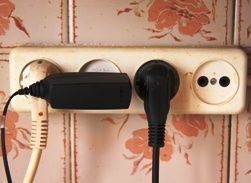Categories: Electrician Secrets, Sockets and switches
Number of views: 310547
Comments on the article: 38
Two phases in your 220 volt outlet? This is more real than you think.
 About a common wiring malfunction when there is a phase in the 220 V sockets on both sockets. About why this is happening and why it is dangerous. First-person and a bit informal.
About a common wiring malfunction when there is a phase in the 220 V sockets on both sockets. About why this is happening and why it is dangerous. First-person and a bit informal.
There is one characteristic malfunction of the wiring, which can confuse a novice or inexperienced electrician. To explain what I’m talking about, I’ll give a story from one of my friends:
“A neighbor comes to me on Saturday - a lonely grandmother. And asks to deal with the electrician in the apartment. Say, nothing works, but the lights did not seem to be turned off.
Well, I, of course, go to the site and check the circuit breakers. Everything is in order, all machines are on. I take the indicator: phase passes by. I go into the apartment to my grandmother, I check the first outlet. The first connector is the “phase”. I check the second connector - also a "phase"! What nonsense!
I turn to another outlet: the same picture. Two phases. Where are the two phases from? Well, suppose, okay, “zero” can disappear. But where can the second phase appear in a 220 volt outlet? Only one phase is brought into the apartment.
I didn’t understand anything, I apologized to the grannies, and she had to wait until Monday to wait for an electrician from the housing office. And what kind of trouble was there, I did not understand. ”
I’ll immediately ask the experts not to laugh at the story of my friend. He is not a stupid person, just not an electrician by profession. And I will shed some light on the dark story that happened to him.
If the hero of the story except indicator screwdriver he had a tester with him, and if he could use it, he would be able to make one interesting observation. There was no voltage between the two “phases” in the outlet. This means that the "phase" was of the same name. It is understandable, otherwise the technology and lamps in the apartment would not have been greeted.
But where did the “phase" get to the conductor, which was previously zero? She just went through the load, that is, for example, through the light of the corridor lamp, which is always on, and ... and that’s it. It turned out that she simply had nowhere to go on. The reason for the whole katavasiya is that the input zero working conductor is cut off. It can simply break off on the zero bus in the shield, for an aluminum wire it is as easy as shelling pears.
When this happens, the current in the circuit, of course, disappears. No current - no voltage drop. Therefore, the “phase" is the same as that at the input, that at the output of the bulb. It turns out a "phase" in both wires. Well, since all the zero wires of the apartment have a direct electrical connection between each other on the same zero tire of the apartment shield, the “lost phase” appears in the outlet too. It was enough to turn off all the switches and disconnect from the sockets all the appliances in the apartment so that the anomaly disappeared.
Well, to correct the situation, it was enough to strip and reconnect the fallen off zero wire, first, of course, turning off the opening bag.
It is worth noting here separately that although the “phase” on the neutral conductor in such situations seems to be illusive and unreal, the danger can be quite real. Even through a load you can be very “pulled” very well, because a person needs only about 7 milliamps for very unpleasant sensations.
Again in order to avoid electric shock in such situations, it is impossible to produce protective grounding housings of electrical appliances directly in the place of their connection, without a separate grounding line and re-grounding. After all, if you neglect this prohibition, then when the neutral wire is broken, you can get the phase directly on the device’s case, even if it’s not quite real.
Read also on this topic: What is zero and phase, how to determine them?
Alexander Molokov
See also at i.electricianexp.com
:
